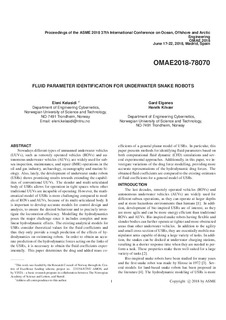| dc.description.abstract | Nowadays different types of unmanned underwater vehicles (UUVs), such as remotely operated vehicles (ROVs) and autonomous underwater vehicles (AUVs), are widely used for subsea inspection, maintenance, and repair (IMR) operations in the oil and gas industry, archaeology, oceanography and marine biology. Also, lately, the development of underwater snake robots (USRs) shows promising results towards extending the capabilities of conventional UUVs. The slender and multi-articulated body of USRs allows for operation in tight spaces where other traditional UUVs are incapable of operating. However, the mathematical model of USRs is more challenging compared to models of ROVs and AUVs, because of its multi-articulated body. It is important to develop accurate models for control design and analysis, to ensure the desired behaviour and to precisely investigate the locomotion efficiency. Modelling the hydrodynamics poses the major challenge since it includes complex and nonlinear hydrodynamic effects. The existing analytical models for USRs consider theoretical values for the fluid coefficients and thus they only provide a rough prediction of the effects of hydrodynamics on swimming robots. In order to obtain an accurate prediction of the hydrodynamic forces acting on the links of the USRs, it is necessary to obtain the fluid coefficients experimentally. This paper determines the drag and added mass co-efficients of a general planar model of USRs. In particular, this paper presents methods for identifying fluid parameters based on both computational fluid dynamic (CFD) simulations and several experimental approaches. Additionally, in this paper, we investigate variations of the drag force modelling, providing more accurate representations of the hydrodynamic drag forces. The obtained fluid coefficients are compared to the existing estimates of fluid coefficients for a general model of USRs. | nb_NO |
